沉淀蛋白质的常用方法
蛋白沉淀方法
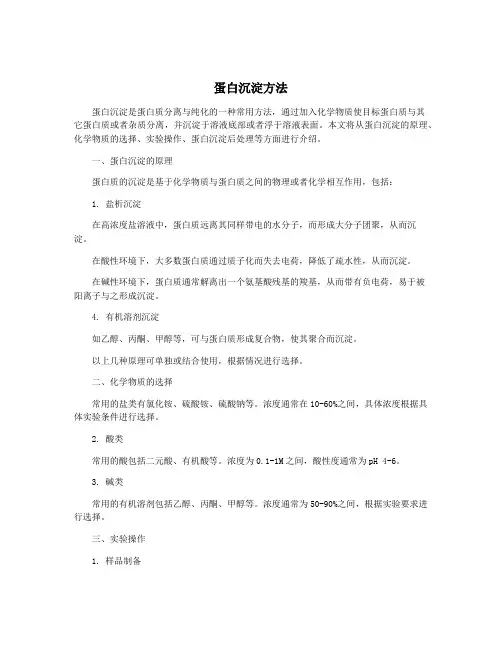
蛋白沉淀方法蛋白沉淀是蛋白质分离与纯化的一种常用方法,通过加入化学物质使目标蛋白质与其它蛋白质或者杂质分离,并沉淀于溶液底部或者浮于溶液表面。
本文将从蛋白沉淀的原理、化学物质的选择、实验操作、蛋白沉淀后处理等方面进行介绍。
一、蛋白沉淀的原理蛋白质的沉淀是基于化学物质与蛋白质之间的物理或者化学相互作用,包括:1. 盐析沉淀在高浓度盐溶液中,蛋白质远离其同样带电的水分子,而形成大分子团聚,从而沉淀。
在酸性环境下,大多数蛋白质通过质子化而失去电荷,降低了疏水性,从而沉淀。
在碱性环境下,蛋白质通常解离出一个氨基酸残基的羧基,从而带有负电荷,易于被阳离子与之形成沉淀。
4. 有机溶剂沉淀如乙醇、丙酮、甲醇等,可与蛋白质形成复合物,使其聚合而沉淀。
以上几种原理可单独或结合使用,根据情况进行选择。
二、化学物质的选择常用的盐类有氯化铵、硫酸铵、硫酸钠等。
浓度通常在10-60%之间,具体浓度根据具体实验条件进行选择。
2. 酸类常用的酸包括二元酸、有机酸等。
浓度为0.1-1M之间,酸性度通常为pH 4-6。
3. 碱类常用的有机溶剂包括乙醇、丙酮、甲醇等。
浓度通常为50-90%之间,根据实验要求进行选择。
三、实验操作1. 样品制备待分离的蛋白质必须经过预处理,通常包括离心、裂解、过滤等步骤。
裂解方式可以使用生理盐水、水、甲醇等,使蛋白质从细胞中释放出来。
过滤可以使用滤纸、滤膜、分子筛等方式,去除杂质。
2. 化学物质的加入将选择好的化学物质加入样品中,此时需注意化学物质前后也要进行科学操作,如一些电解质类物质可能带有杂质,需要先进行过滤;有机溶剂可能会引起蛋白质的变性,需加入适量的缓冲液进行保护。
将混合物小心地混合均匀后,离心使混合物分层,此时目标蛋白沉在沉淀层,上清液中还有一些蛋白,需要将其过滤或沉淀以去除杂质。
4. 纯化将沉淀分解,得到的产物通过离心、层析等步骤进行纯化,最终得到目标蛋白。
沉淀后需要进行洗涤,以去除杂质,保证目标蛋白的纯度和酶效。
蛋白沉淀法
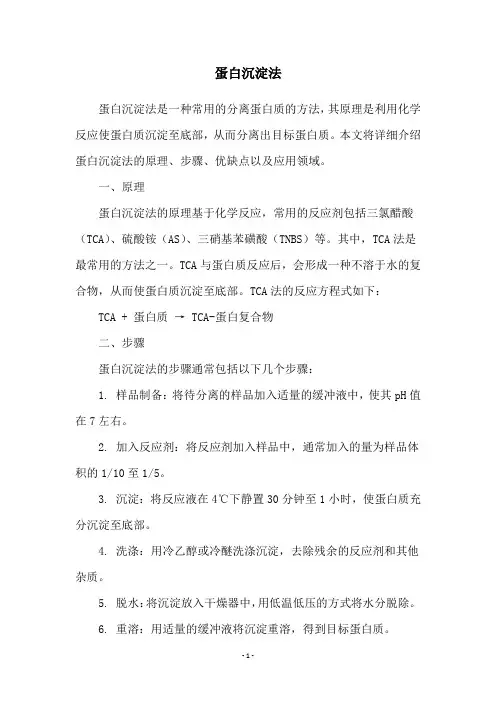
蛋白沉淀法蛋白沉淀法是一种常用的分离蛋白质的方法,其原理是利用化学反应使蛋白质沉淀至底部,从而分离出目标蛋白质。
本文将详细介绍蛋白沉淀法的原理、步骤、优缺点以及应用领域。
一、原理蛋白沉淀法的原理基于化学反应,常用的反应剂包括三氯醋酸(TCA)、硫酸铵(AS)、三硝基苯磺酸(TNBS)等。
其中,TCA法是最常用的方法之一。
TCA与蛋白质反应后,会形成一种不溶于水的复合物,从而使蛋白质沉淀至底部。
TCA法的反应方程式如下:TCA + 蛋白质→ TCA-蛋白复合物二、步骤蛋白沉淀法的步骤通常包括以下几个步骤:1. 样品制备:将待分离的样品加入适量的缓冲液中,使其pH值在7左右。
2. 加入反应剂:将反应剂加入样品中,通常加入的量为样品体积的1/10至1/5。
3. 沉淀:将反应液在4℃下静置30分钟至1小时,使蛋白质充分沉淀至底部。
4. 洗涤:用冷乙醇或冷醚洗涤沉淀,去除残余的反应剂和其他杂质。
5. 脱水:将沉淀放入干燥器中,用低温低压的方式将水分脱除。
6. 重溶:用适量的缓冲液将沉淀重溶,得到目标蛋白质。
三、优缺点1. 优点:蛋白沉淀法操作简单,成本低廉,适用于大规模分离蛋白质。
此外,该方法还可以去除大量的杂质和非蛋白质物质。
2. 缺点:蛋白沉淀法的选择性不够高,可能会将多种蛋白质沉淀至底部。
此外,该方法会对蛋白质的结构和功能产生一定的影响,使得蛋白质的活性降低。
四、应用领域蛋白沉淀法广泛应用于生物学、生化学、医学等领域。
其中,最常见的应用包括:1. 分离纯化蛋白质:蛋白沉淀法可以将目标蛋白质从复杂的混合物中分离出来,得到较为纯净的蛋白质样品。
2. 检测蛋白质含量:蛋白沉淀法可以用于检测样品中蛋白质的含量,并进行定量分析。
3. 蛋白质结构研究:蛋白沉淀法可以用于分离蛋白质的亚单位,从而研究蛋白质的结构和功能。
总之,蛋白沉淀法是一种常用的分离蛋白质的方法,其原理简单,操作方便,适用于大规模分离蛋白质。
但是,由于其选择性不够高,会对蛋白质的结构和功能产生一定的影响,因此在具体应用时需谨慎选择。
蛋白质沉淀方法及特点。
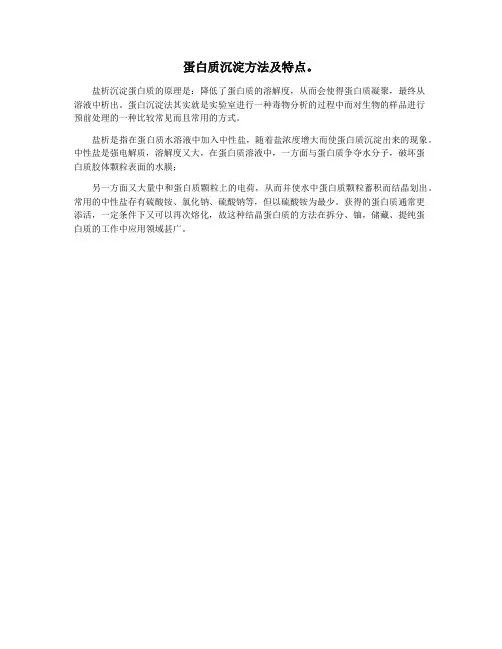
蛋白质沉淀方法及特点。
盐析沉淀蛋白质的原理是:降低了蛋白质的溶解度,从而会使得蛋白质凝聚,最终从
溶液中析出。
蛋白沉淀法其实就是实验室进行一种毒物分析的过程中而对生物的样品进行
预前处理的一种比较常见而且常用的方式。
盐析是指在蛋白质水溶液中加入中性盐,随着盐浓度增大而使蛋白质沉淀出来的现象。
中性盐是强电解质,溶解度又大,在蛋白质溶液中,一方面与蛋白质争夺水分子,破坏蛋
白质胶体颗粒表面的水膜;
另一方面又大量中和蛋白质颗粒上的电荷,从而并使水中蛋白质颗粒蓄积而结晶划出。
常用的中性盐存有硫酸铵、氯化钠、硫酸钠等,但以硫酸铵为最少。
获得的蛋白质通常更
添活,一定条件下又可以再次熔化,故这种结晶蛋白质的方法在拆分、铀,储藏、提纯蛋
白质的工作中应用领域甚广。
蛋白质沉淀
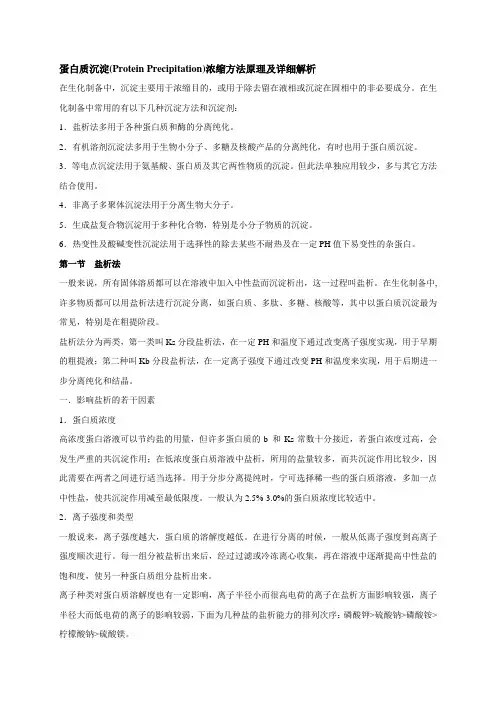
蛋白质沉淀(Protein Precipitation)浓缩方法原理及详细解析在生化制备中,沉淀主要用于浓缩目的,或用于除去留在液相或沉淀在固相中的非必要成分。
在生化制备中常用的有以下几种沉淀方法和沉淀剂:1.盐析法多用于各种蛋白质和酶的分离纯化。
2.有机溶剂沉淀法多用于生物小分子、多糖及核酸产品的分离纯化,有时也用于蛋白质沉淀。
3.等电点沉淀法用于氨基酸、蛋白质及其它两性物质的沉淀。
但此法单独应用较少,多与其它方法结合使用。
4.非离子多聚体沉淀法用于分离生物大分子。
5.生成盐复合物沉淀用于多种化合物,特别是小分子物质的沉淀。
6.热变性及酸碱变性沉淀法用于选择性的除去某些不耐热及在一定PH值下易变性的杂蛋白。
第一节盐析法一般来说,所有固体溶质都可以在溶液中加入中性盐而沉淀析出,这一过程叫盐析。
在生化制备中,许多物质都可以用盐析法进行沉淀分离,如蛋白质、多肽、多糖、核酸等,其中以蛋白质沉淀最为常见,特别是在粗提阶段。
盐析法分为两类,第一类叫Ks分段盐析法,在一定PH和温度下通过改变离子强度实现,用于早期的粗提液;第二种叫Kb分段盐析法,在一定离子强度下通过改变PH和温度来实现,用于后期进一步分离纯化和结晶。
一.影响盐析的若干因素1.蛋白质浓度高浓度蛋白溶液可以节约盐的用量,但许多蛋白质的b 和Ks常数十分接近,若蛋白浓度过高,会发生严重的共沉淀作用;在低浓度蛋白质溶液中盐析,所用的盐量较多,而共沉淀作用比较少,因此需要在两者之间进行适当选择。
用于分步分离提纯时,宁可选择稀一些的蛋白质溶液,多加一点中性盐,使共沉淀作用减至最低限度。
一般认为2.5%-3.0%的蛋白质浓度比较适中。
2.离子强度和类型一般说来,离子强度越大,蛋白质的溶解度越低。
在进行分离的时候,一般从低离子强度到高离子强度顺次进行。
每一组分被盐析出来后,经过过滤或冷冻离心收集,再在溶液中逐渐提高中性盐的饱和度,使另一种蛋白质组分盐析出来。
蛋白质的沉淀的方法
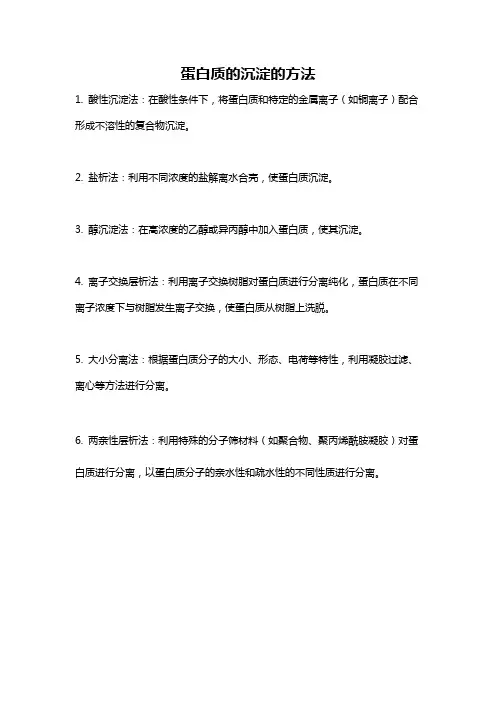
蛋白质的沉淀的方法
1. 酸性沉淀法:在酸性条件下,将蛋白质和特定的金属离子(如铜离子)配合形成不溶性的复合物沉淀。
2. 盐析法:利用不同浓度的盐解离水合壳,使蛋白质沉淀。
3. 醇沉淀法:在高浓度的乙醇或异丙醇中加入蛋白质,使其沉淀。
4. 离子交换层析法:利用离子交换树脂对蛋白质进行分离纯化,蛋白质在不同离子浓度下与树脂发生离子交换,使蛋白质从树脂上洗脱。
5. 大小分离法:根据蛋白质分子的大小、形态、电荷等特性,利用凝胶过滤、离心等方法进行分离。
6. 两亲性层析法:利用特殊的分子筛材料(如聚合物、聚丙烯酰胺凝胶)对蛋白质进行分离,以蛋白质分子的亲水性和疏水性的不同性质进行分离。
沉淀蛋白质的常用方法
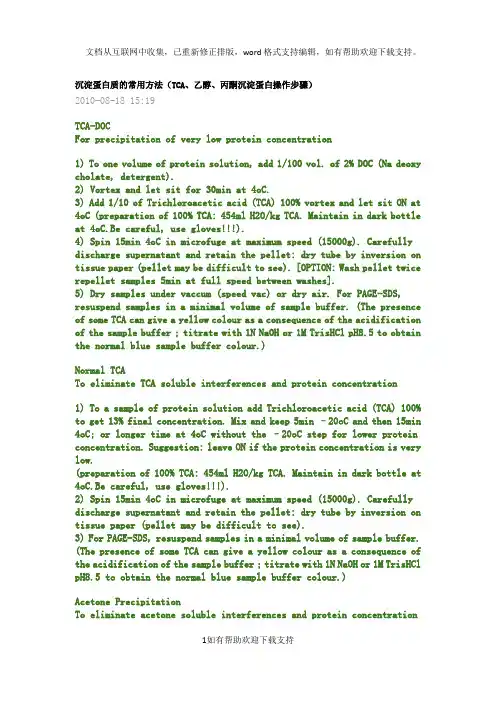
沉淀蛋白质的常用方法(TCA、乙醇、丙酮沉淀蛋白操作步骤)2010-08-18 15:19TCA-DOCFor precipitation of very low protein concentration1) To one volume of protein solution, add 1/100 vol. of 2% DOC (Na deoxy cholate, detergent).2) Vortex and let sit for 30min at 4oC.3) Add 1/10 of Trichloroacetic acid (TCA) 100% vortex and let sit ON at 4oC (preparation of 100% TCA: 454ml H2O/kg TCA. Maintain in dark bottle at 4oC.Be careful, use gloves!!!).4) Spin 15min 4oC in microfuge at maximum speed (15000g). Carefully discharge supernatant and retain the pellet: dry tube by inversion on tissue paper (pellet may be difficult to see). [OPTION: Wash pellet twice repellet samples 5min at full speed between washes].5) Dry samples under vaccum (speed vac) or dry air. For PAGE-SDS, resuspend samples in a minimal volume of sample buffer. (The presence of some TCA can give a yellow colour as a consequence of the acidification of the sample buffer ; titrate with 1N NaOH or 1M TrisHCl pH8.5 to obtain the normal blue sample buffer colour.)Normal TCATo eliminate TCA soluble interferences and protein concentration1) To a sample of protein solution add Trichloroacetic acid (TCA) 100% to get 13% final concentration. Mix and keep 5min –20oC and then 15min 4oC; or longer time at 4oC without the –20oC step for lower protein concentration. Suggestion: leave ON if the protein concentration is very low.(preparation of 100% TCA: 454ml H2O/kg TCA. Maintain in dark bottle at 4oC.Be careful, use gloves!!!).2) Spin 15min 4oC in microfuge at maximum speed (15000g). Carefully discharge supernatant and retain the pellet: dry tube by inversion on tissue paper (pellet may be difficult to see).3) For PAGE-SDS, resuspend samples in a minimal volume of sample buffer. (The presence of some TCA can give a yellow colour as a consequence of the acidification of the sample buffer ; titrate with 1N NaOH or 1M TrisHCl pH8.5 to obtain the normal blue sample buffer colour.)Acetone PrecipitationTo eliminate acetone soluble interferences and protein concentration1) Add 1 volume of protein solution to 4 volumes of cold acetone. Mix and keep at least 20min –20oC. (Suggestion: leave ON if the protein concentration is very low).2) Spin 15min 4oC in microfuge at maximum speed (15000g). Carefully discharge supernatant and retain the pellet: dry tube by inversion on tissue paper (pellet may be difficult to see).3) Dry samples under vaccum (speed-vac) or dry air to eliminate any acetone residue (smell tubes). For PAGE-SDS, resuspend samples in a minimal volume of sample buffer.Ethanol PrecipitationUseful method to concentrate proteins and removal of Guanidine Hydrochloride before PAGE-SDS1) Add to 1 volume of protein solution 9 volumes of cold Ethanol 100%. Mix and keep at least 10min.at –20oC. (Suggestion: leave ON).2) Spin 15min 4oC in microcentrifuge at maximum speed (15000g). Carefully discharge supernatant and retain the pellet: dry tube by inversion on tissue paper (pellet may be difficult to see).3) Wash pellet with 90% cold ethanol (keep at –20oC). Vortex and repellet samples 5min at full speed.4) Dry samples under vaccum (speed vac) or dry air to eliminate any ethanol residue (smell tubes). For PAGE-SDS, resuspend samples in a minimal volume of sample buffer.TCA-DOC/AcetoneUseful method to concentrate proteins and remove acetone and TCA soluble interferences1. To one volume of protein solution add 2% Na deoxycholate (DOC) to 0.02% final (for 100 μl sample, add 1 μl 2% DOC).2. Mix and keep at room temperature for at least 15 min.3. 100% trichloroacetic acid (TCA) to get 10% final concentration (preparation of 100% TCA: 454ml H2O/kg TCA. Maintain in dark bottle at 4oC.Be careful, use gloves!!!).4. Mix and keep at room temperature for at least 1 hour.5. Spin at 4oC for 10 min, remove supernatant and retain the pellet. Dry tube by inversion on tissue paper.6. Add 200 μl of ice cold acetone to TCA pellet.7. Mix and keep on ice for at least 15 min.8. Spin at 4oC for 10 min in microcentrifuge at maximum speed.9. Remove supernatant as before (5), dry air pellet to eliminate anyacetone residue (smell tubes). For PAGE-SDS, resuspend samples in a minimal volume of sample buffer.10. (The presence of some TCA can give a yellow colour as a consequence of the acidification of the sample buffer ; titrate with 1N NaOH or 1M TrisHCl pH8.5 to obtain the normal blue sample buffer colour.)Acidified Acetone/MethanolUseful method to remove acetone and methanol soluble interferences like SDS before IEF1) Prepare acidified acetone: 120ml acetone + 10μl H Cl (1mM final concentration).2) Prepare precipitation reagent: Mix equal volumes of acidified acetone and methanol and keep at -20oC.3) To one volume of protein solution add 4 volumes of cold precipitation reagent. Mix and keep ON at -20oC.4) Spin 15min 4oC in microfuge at maximum speed (15000g). Carefully discharge supernatant and retain the pellet: dry tube by inversion on tissue paper (pellet may be difficult to see).5) Dry samples under vaccum (speed-vac) or dry air to eliminate any acetone or methanol residue (smell tubes).TCA-Ethanol PrecipitationUseful method to concentrate proteins and removal of Guanidine Hydrochloride before PAGE-SDS1) Dilute 10-25μl samples to 100μl with H2OAdd 100μl of 20% trichloroacetic acid (TCA) and mix (prepa ration of 100% TCA: 454ml H2O/kg TCA. Maintain in dark bottle at 4oC.Be careful, use gloves!!!).2) Leave in ice for 20min. Spin at 4oC for 15 min in microcentrifuge at maximum speed.3) Carefully discharge supernatant and retain the pellet: dry tube by inversion on tissue (pellet may be difficult to see).4) Wash pellet with 100μl ice-cold ethanol, dry and resuspend in sample buffer.5) In case there are traces of GuHCl present, samples should be loaded immediately after boiling for 7 min at 95°C6) (The presence of some TCA can give a yellow colour as a consequence of the acidification of the sample buffer ; titrate with 1N NaOH or 1M TrisHCl pH8.5 to obtain the normal blue sample buffer colour.)PAGE prepTM Protein Clean-up and Enrichment Kit - PIERCEThe PAGE prep? Kit enables removal of many chemicals that interfere with SDS-PAGE analysis: guanidine, ammonium sulfate, other common salts, acids and bases, detergents, dyes, DNA, RNA, and lipids.PIERCE: #26800 - PAGE prepTM Protein Clean-up and Enrichment Kit (pdf)Chloroform Methanol PrecipitationUseful method for Removal of salt and detergents1) To sample of starting volume 100 ul2) Add 400 ul methanol3) Vortex well4) Add 100 ul chloroform5) Vortex6) Add 300 ul H2O7) Vortex8) Spin 1 minute @ 14,0000 g9) Remove top aqueous layer (protein is between layers)10) Add 400 ul methanol11) Vortex12) Spin 2 minutes @ 14,000 g13) Remove as much MeOH as possible without disturbing pellet14) Speed-Vac to dryness15) Bring up in 2X sample buffer for PAGEReference: Wessel, D. and Flugge, U. I. Anal. Biochem. (1984) 138, 141-143哈哈,我做过这个论文哈!1. 配胶缓冲液系统对电泳的影响?在SDS-PAGE不连续电泳中,制胶缓冲液使用的是Tris-HCL缓冲系统,浓缩胶是pH6.7,分离胶pH8.9;而电泳缓冲液使用的Tris-甘氨酸缓冲系统。
沉淀蛋白质的常用方法(TCA、乙醇、丙酮沉淀蛋白操作步骤)
沉淀蛋白质的常用方法(TCA、乙醇、丙酮沉淀蛋白操作步骤)TCA-DOCFor precipitation of very low protein concentration1) To one volume of protein solution, add 1/100 vol. of 2% DOC (Na deoxycholate, detergent).2) V ortex and let sit for 30min at 4oC.3) Add 1/10 of Trichloroacetic acid (TCA) 100% vortex and let sit ON at 4oC (preparation of 100% TCA: 454ml H2O/kg TCA. Maintain in dark bottleat 4oC.Be careful, use gloves).4) Spin 15min 4oC in microfuge at maximum speed (15000g). Carefully discharge supernatant and retain the pellet: dry tube by inversion on tissue paper (pellet may be difficult to see). [OPTION: W ash pellet twice with one volume of cold acetone (acetone keep at –20oC). Vortex and repellet samples 5min at full speed between washes].5) Dry samples under vaccum (speed vac) or dry air. For PA GE-SDS, resuspend samples in a minimal volume of sample buffer. (The presence of some TCA can give a yellow colour as a consequence of the acidification of the sample buffer ; titrate with 1N NaOH or 1M TrisHCl pH8.5 to obtain the normal blue sample buffer colour.)Normal TCATo eliminate TCA soluble interferences and protein concentration1) To a sample of protein solution add Trichloroacetic acid (TCA) 100% to get 13% final concentration. Mix and keep 5min –20oC and then 15min 4oC; or longer time at 4oC without the –20oC step for lower protein concentration. Suggestion: leave ON if the protein concentration is very low. (preparation of 100% TCA: 454ml H2O/kg TCA. Maintain in dark bottleat 4oC.Be careful, use gloves).2) Spin 15min 4oC in microfuge at maximum speed (15000g). Carefully discharge supernatant and retain the pellet: dry tube by inversion on tissue paper (pellet may be difficult to see).3) For PA GE-SDS, resuspend samples in a minimal volume of sample buffer. (The presence of some TCA can give a yellow colour as a consequence of the acidification of the sample buffer ; titrate with 1N NaOH or 1M TrisHCl pH8.5 to obtain the normal blue sample buffer colour.)Acetone PrecipitationTo eliminate acetone soluble interferences and protein concentration1) Add to 1 volume of protein solution 4 volumes of cold acetone. Mix and keep at least 20min –20oC. (Suggestion: leave ON if the protein concentration is very low).2) Spin 15min 4oC in microfuge at maximum speed (15000g). Carefully discharge supernatant and retain the pellet: dry tube by inversion on tissue paper (pellet may be difficult to see).3) Dry samples under vaccum (speed-vac) or dry air to eliminate any acetone residue (smell tubes). For PA GE-SDS, resuspend samples in a minimal volume of sample buffer.Ethanol PrecipitationUseful method to concentrate proteins and removal of Guanidine Hydrochloride before P AGE-SDS 1)Add to 1 volume of protein solution 9 volumes of cold Ethanol 100%. Mix and keep at least 10min.at –20oC. (Suggestion: leave ON).2) Spin 15min 4oC in microcentrifuge at maximum speed (15000g). Carefully discharge supernatant and retain the pellet: dry tube by inversion on tissue paper (pellet may be difficult to see).3) Wash pellet with 90% cold ethanol (keep at –20oC). V ortex and repellet samples 5min at full speed.4) Dry samples under vaccum (speed vac) or dry air to eliminate any ethanol residue (smell tubes). For PA GE-SDS, resuspend samples in a minimal volume of sample buffer.TCA-DOC/AcetoneUseful method to concentrate proteins and remove acetone and TCA soluble interferences1. To one volume of protein solution add 2% Na deoxycholate (DOC) to 0.02% final (for 100 μl sample, add 1 μl 2% DOC).2. Mix and keep at room temperature for at least 15 min.3. 100% trichloroacetic acid (TCA) to get 10% final concentration (preparation of 100% TCA: 454ml H2O/kg TCA. Maintain in dark bottleat 4oC.Be careful, use gloves).4. Mix and keep at room temperature for at least 1 hour.5. Spin at 4oC for 10 min, remove supernatant and retain the pellet. Dry tube by inversion on tissue paper.6. Add 200 μl of ice cold acetone to TCA pellet.7. Mix and keep on ice for at least 15 min.8. Spin at 4oC for 10 min in microcentrifuge at maximum speed.9. Remove supernatant as before (5), dry air pellet to eliminate any acetone residue (s mell tubes). For PAGE-SDS, resuspend samples in a minimal volume of sample buffer.10. (The presence of some TCA can give a yellow colour as a consequence of the acidification of the sample buffer ; titrate with 1N NaOH or 1M TrisHCl pH8.5 to obtain the normal blue sample buffer colour.)Acidified Acetone/MethanolUseful method to remove acetone and methanol soluble interferences like SDS before IEF1) Prepare acidif ied acetone: 120ml acetone + 10μl HCl (1mM final concentration).2) Prepare precipitation reagent: Mix equal volumes of acidified acetone and methanol and keep at -20oC.3) To one volume of protein solution add 4 volumes of cold precipitation reagent. Mi x and keep ON at -20oC.4) Spin 15min 4oC in microfuge at maximum speed (15000g). Carefully discharge supernatant and retain the pellet: dry tube by inversion on tissue paper (pellet may be difficult to see).5) Dry samples under vaccum (speed-vac) or dry air to eliminate any acetone or methanol residue (smell tubes).TCA-Ethanol PrecipitationUseful method to concentrate proteins and removal of Guanidine Hydrochloride before P AGE-SDS 1) Dilute 10-25μl samples to 100μl with H2OAdd 100μl of 20% trichlo roacetic acid (TCA) and mix (preparation of 100% TCA: 454ml H2O/kg TCA. Maintain in dark bottleat 4oC.Be careful, use gloves).2) Leave in ice for 20min. Spin at 4oC for 15 min in microcentrifuge at maximum speed.3) Carefully discharge supernatant and retain the pellet: dry tube by inversion on tissue (pellet may be difficult to see).4) Wash pellet with 100μl ice-cold ethanol, dry and resuspend in sample buffer.5) In case there are traces of GuHCl present, samples should be loaded immediately after boiling for 7 min at 95°C6) (The presence of some TCA can give a yellow colour as a consequence of the acidification of the sample buffer ; titrate with 1N NaOH or 1M TrisHCl pH8.5 to obtain the normal blue sample buffer colour.)PAGE prep TM Protein Clean-up and Enrichment Kit - PIERCEThe P AGEprep? Kit enables removal of many chemicals that interfere with SDS-P AGE analysis: guanidine, ammonium sulfate, other common salts, acids and bases, detergents, dyes, DNA, RNA, and lipids.PIERCE: #26800 - PA GE prep TM Protein Clean-up and Enrichment Kit(pdf)Chloroform Methanol PrecipitationUseful method for Removal of salt and detergents2)1) To sample of starting volume 100 ul2) Add 400 ul methanol3) V ortex well4) Add 100 ul chloroform5) V ortex6) Add 300 ul H2O7) V ortex8) Spin 1 minute @ 14,0000 g9) Remove top aqueous layer (protein is between layers)10) Add 400 ul methanol11) V ortex12) Spin 2 minutes @ 14,000 g13) Remove as much MeOH as possible without disturbing pellet14) Speed-V ac to dryness15) Bring up in 2X sample buffer for PA GEReference: W essel, D. and Flugge, U. I. Anal. Biochem. (1984) 138, 141-143三氯乙酸(TCA)沉淀蛋白的原理12TCA与蛋白质之间主要有以下几个方面的作用:①在酸性条件下与蛋白质形成不溶性盐;②作为蛋白质变性剂使蛋白质构象发生改变,暴露出较多的疏水性基团, 使之聚集沉淀;③随着蛋白质分子量的增大,其结构复杂性与致密性越大,TCA可能渗入分子内部而使之较难被完全除去,在电泳前样品加热处理时可能使蛋白质结构发生酸水解而形成碎片,而且随时间的延长这一作用愈加明显;④电泳图谱显示,BSA、HSA单体谱带有较明显的展宽现象,这可能是由于TCA的结合,使SDS 与蛋白质的结合量产生偏差,从而造成蛋白质所带电荷的不均一性,造成迁移率的不一致。
蛋白质沉淀的方法
蛋白质沉淀的方法蛋白质沉淀是生物化学实验中常见的步骤,它可以帮助我们从混合物中分离出目标蛋白质。
在实验室中,有多种方法可以用来沉淀蛋白质,下面将介绍几种常见的方法及其操作步骤。
一、盐析法。
盐析法是一种常用的蛋白质沉淀方法,它利用蛋白质在高盐浓度下沉淀的特性来实现分离。
具体操作步骤如下:1. 将待沉淀的蛋白质溶液加入适量的盐溶液中,使盐浓度达到蛋白质的盐饱和度。
2. 静置一段时间,让蛋白质在高盐浓度下沉淀。
3. 用离心机将混合物进行离心,将沉淀的蛋白质分离出来。
二、醋酸铵沉淀法。
醋酸铵沉淀法是另一种常用的蛋白质沉淀方法,它利用蛋白质在醋酸铵高浓度下沉淀的特性来实现分离。
具体操作步骤如下:1. 将待沉淀的蛋白质溶液加入适量的醋酸铵溶液中,使醋酸铵浓度达到蛋白质的饱和度。
2. 静置一段时间,让蛋白质在高醋酸铵浓度下沉淀。
3. 用离心机将混合物进行离心,将沉淀的蛋白质分离出来。
三、甲醇沉淀法。
甲醇沉淀法是一种常用的有机溶剂沉淀蛋白质的方法,它利用蛋白质在甲醇中的沉淀特性来实现分离。
具体操作步骤如下:1. 将待沉淀的蛋白质溶液加入适量的甲醇中,使蛋白质在甲醇中沉淀。
2. 静置一段时间,让蛋白质充分沉淀。
3. 用离心机将混合物进行离心,将沉淀的蛋白质分离出来。
四、硫酸铵沉淀法。
硫酸铵沉淀法是一种利用硫酸铵对蛋白质的沉淀作用来实现分离的方法。
具体操作步骤如下:1. 将待沉淀的蛋白质溶液加入适量的硫酸铵溶液中,使硫酸铵浓度达到蛋白质的饱和度。
2. 静置一段时间,让蛋白质在高硫酸铵浓度下沉淀。
3. 用离心机将混合物进行离心,将沉淀的蛋白质分离出来。
以上就是几种常见的蛋白质沉淀方法及其操作步骤,希望对您有所帮助。
在进行实验操作时,要根据具体情况选择合适的方法,并严格按照操作步骤进行操作,以确保实验的准确性和可靠性。
蛋白质的沉淀反应实验报告
蛋白质的沉淀反应实验报告一、实验目的1、掌握几种常用的使蛋白质沉淀的方法。
2、理解蛋白质沉淀的原理和应用。
二、实验原理蛋白质是一种大分子化合物,在溶液中以胶体状态存在。
当溶液条件发生改变时,蛋白质的胶体稳定性被破坏,从而发生沉淀。
常见的使蛋白质沉淀的方法有以下几种:1、盐析法:在蛋白质溶液中加入大量中性盐(如硫酸铵、氯化钠等),破坏蛋白质的水化膜和电荷,使其溶解度降低而沉淀。
2、有机溶剂沉淀法:向蛋白质溶液中加入一定量的有机溶剂(如乙醇、丙酮等),降低溶液的介电常数,增加蛋白质分子间的静电引力,导致蛋白质沉淀。
3、重金属盐沉淀法:重金属离子(如汞离子、铅离子等)与蛋白质分子中的巯基等基团结合,使蛋白质变性沉淀。
4、生物碱试剂沉淀法:生物碱试剂(如苦味酸、鞣酸等)能与蛋白质分子中的碱性基团结合,生成不溶性盐而沉淀。
三、实验材料和仪器1、材料鸡蛋白溶液:将新鲜鸡蛋的蛋清用蒸馏水稀释 10 倍。
10%硫酸铵溶液、饱和硫酸铵溶液、3%硝酸银溶液、01mol/L 硫酸铜溶液、5%三氯乙酸溶液、95%乙醇、1%醋酸铅溶液、10%氢氧化钠溶液、1%醋酸溶液、苦味酸饱和溶液、鞣酸饱和溶液。
2、仪器试管、试管架、滴管、玻璃棒、离心机。
四、实验步骤1、盐析法取两支试管,分别加入 2mL 鸡蛋白溶液。
向其中一支试管中逐滴加入 10%硫酸铵溶液,边加边振荡,直至出现沉淀。
观察沉淀的生成情况。
向另一支试管中加入 2mL 饱和硫酸铵溶液,振荡均匀。
静置一段时间后,观察沉淀现象。
2、有机溶剂沉淀法取两支试管,分别加入 2mL 鸡蛋白溶液。
向其中一支试管中逐滴加入 95%乙醇,边加边振荡,直至出现沉淀。
观察沉淀的生成情况。
向另一支试管中加入 2mL 丙酮,振荡均匀。
静置一段时间后,观察沉淀现象。
3、重金属盐沉淀法取三支试管,分别加入 2mL 鸡蛋白溶液。
向第一支试管中滴加 3%硝酸银溶液 2~3 滴,振荡均匀,观察沉淀的生成情况。
蛋白质沉淀法详解
蛋白质沉淀法详解蛋白质通过盐析的办法沉淀的原理是降低蛋白质的溶解度,使蛋白质凝聚而从溶液中析出。
蛋白质的沉淀(protein precipitation),沉淀是溶液中的溶质由液相变成固相析出的过程。
蛋白质从溶液中析出的现象,称为蛋白质的沉淀。
蛋白质沉淀常用的方法有盐析、等电点沉淀、有机溶剂沉淀、生物碱试剂与某些酸(如三氯醋酸)沉淀等。
在生化制备中,沉淀主要用于浓缩目的,或用于除去留在液相或沉淀在固相中的非必要成分。
在生化制备中常用的有以下几种沉淀方法和沉淀剂:1.盐析法多用于各种蛋白质和酶的分离纯化。
2.有机溶剂沉淀法多用于生物小分子、多糖及核酸产品的分离纯化,有时也用于蛋白质沉淀。
3.等电点沉淀法用于氨基酸、蛋白质及其它两性物质的沉淀。
但此法单独应用较少,多与其它方法结合使用。
4.非离子多聚体沉淀法用于分离生物大分子。
5.生成盐复合物沉淀用于多种化合物,特别是小分子物质的沉淀。
6.热变性及酸碱变性沉淀法用于选择性的除去某些不耐热及在一定PH值下易变性的杂蛋白。
第一节盐析法一般来说,所有固体溶质都可以在溶液中加入中性盐而沉淀析出,这一过程叫盐析。
在生化制备中,许多物质都可以用盐析法进行沉淀分离,如蛋白质、多肽、多糖、核酸等,其中以蛋白质沉淀最为常见,特别是在粗提阶段。
盐析法分为两类,第一类叫Ks分段盐析法,在一定PH和温度下通过改变离子强度实现,用于早期的粗提液;第二种叫b分段盐析法,在一定离子强度下通过改变PH和温度来实现,用于后期进一步分离纯化和结晶。
一.影响盐析的若干因素1.蛋白质浓度高浓度蛋白溶液可以节约盐的用量,但许多蛋白质的b 和Ks常数十分接近,若蛋白浓度过高,会发生严重的共沉淀作用;在低浓度蛋白质溶液中盐析,所用的盐量较多,而共沉淀作用比较少,因此需要在两者之间进行适当选择。
用于分步分离提纯时,宁可选择稀一些的蛋白质溶液,多加一点中性盐,使共沉淀作用减至最低限度。
一般认为2.5%-3.0%的蛋白质浓度比较适中。
- 1、下载文档前请自行甄别文档内容的完整性,平台不提供额外的编辑、内容补充、找答案等附加服务。
- 2、"仅部分预览"的文档,不可在线预览部分如存在完整性等问题,可反馈申请退款(可完整预览的文档不适用该条件!)。
- 3、如文档侵犯您的权益,请联系客服反馈,我们会尽快为您处理(人工客服工作时间:9:00-18:30)。
沉淀蛋白质的常用方法(TCA、乙醇、丙酮沉淀蛋白操作步骤)TCA-DOCFor precipitation of very low protein concentration1) To one volume of protein solution, add 1/100 vol. of 2% DOC (Na deoxycholate, detergent).2) Vortex and let sit for 30min at 4oC.3) Add 1/10 of Trichloroacetic acid (TCA) 100% vortex and let sit ON at 4oC (preparation of 100% TCA: 454ml H2O/kg TCA. Maintain in dark bottleat careful, use gloves!!!).4) Spin 15min 4oC in microfuge at maximum speed (15000g). Carefully discharge supernatant and retain the pellet: dry tube by inversion on tissue paper (pellet may be difficult to see). [OPTION: Wash pellet twice with one volume of cold acetone (acetone keep at –20oC). Vortex and repellet samples 5min at full speed between washes].5) Dry samples under vaccum (speed vac) or dry air. For PAGE-SDS, resuspend samples in a minimal volume of sample buffer. (The presence of some TCA can give a yellow colour as a consequence of the acidification of the sample buffer ; titrate with 1N NaOH or 1M TrisHCl to obtain the normal blue sample buffer colour.)Normal TCATo eliminate TCA soluble interferences and protein concentration1) To a sample of protein solution add Trichloroacetic acid (TCA) 100% to get 13% final concentration. Mix and keep 5min –20oC and then 15min 4oC; or longer time at 4oC without the –20oC step for lower protein concentration. Suggestion: leave ON if the protein concentration is very low.(preparation of 100% TCA: 454ml H2O/kg TCA. Maintain in dark bottleat careful, use gloves!!!).2) Spin 15min 4oC in microfuge at maximum speed (15000g). Carefully discharge supernatant and retain the pellet: dry tube by inversion on tissue paper (pellet may be difficult to see).3) For PAGE-SDS, resuspend samples in a minimal volume of sample buffer. (The presence of some TCA can give a yellow colour as a consequence ofthe acidification of the sample buffer ; titrate with 1N NaOH or 1M TrisHCl to obtain the normal blue sample buffer colour.)Acetone PrecipitationTo eliminate acetone soluble interferences and protein concentration1) Add to 1 volume of protein solution 4 volumes of cold acetone. Mix and keep at least 20min –20oC. (Suggestion: leave ON if the protein concentration is very low).2) Spin 15min 4oC in microfuge at maximum speed (15000g). Carefully discharge supernatant and retain the pellet: dry tube by inversion on tissue paper (pellet may be difficult to see).3) Dry samples under vaccum (speed-vac) or dry air to eliminate any acetone residue (smell tubes). For PAGE-SDS, resuspend samples in a minimal volume of sample buffer.Ethanol PrecipitationUseful method to concentrate proteins and removal of Guanidine Hydrochloride before PAGE-SDS1) Add to 1 volume of protein solution 9 volumes of cold Ethanol 100%. Mix and keep at least –20oC. (Suggestion: leave ON).2) Spin 15min 4oC in microcentrifuge at maximum speed (15000g). Carefully discharge supernatant and retain the pellet: dry tube by inversion on tissue paper (pellet may be difficult to see).3) Wash pellet with 90% cold ethanol (keep at –20oC). Vortex and repellet samples 5min at full speed.4) Dry samples under vaccum (speed vac) or dry air to eliminate any ethanol residue (smell tubes). For PAGE-SDS, resuspend samples in a minimal volume of sample buffer.TCA-DOC/AcetoneUseful method to concentrate proteins and remove acetone and TCA soluble interferences1. To one volume of protein solution add 2% Na deoxycholate (DOC) to % final (for 100 μl sample, add 1 μl 2% DOC).2. Mix and keep at room temperature for at least 15 min.3. 100% trichloroacetic acid (TCA) to get 10% final concentration (preparation of 100% TCA: 454ml H2O/kg TCA. Maintain in dark bottleat careful, use gloves!!!).4. Mix and keep at room temperature for at least 1 hour.5. Spin at 4oC for 10 min, remove supernatant and retain the pellet. Dry tube by inversion on tissue paper.6. Add 200 μl of ice cold acetone to TCA pellet.7. Mix and keep on ice for at least 15 min.8. Spin at 4oC for 10 min in microcentrifuge at maximum speed.9. Remove supernatant as before (5), dry air pellet to eliminate any acetone residue (smell tubes). For PAGE-SDS, resuspend samples in a minimal volume of sample buffer.10. (The presence of some TCA can give a yellow colour as a consequence of the acidification of the sample buffer ; titrate with 1N NaOH or 1M TrisHCl to obtain the normal blue sample buffer colour.)Acidified Acetone/MethanolUseful method to remove acetone and methanol soluble interferences like SDS before IEF1) Prepare acidified acetone: 120ml acetone + 10μl HCl (1mM final concentration).2) Prepare precipitation reagent: Mix equal volumes of acidified acetone and methanol and keep at -20oC.3) To one volume of protein solution add 4 volumes of cold precipitation reagent. Mix and keep ON at -20oC.4) Spin 15min 4oC in microfuge at maximum speed (15000g). Carefully discharge supernatant and retain the pellet: dry tube by inversion on tissue paper (pellet may be difficult to see).5) Dry samples under vaccum (speed-vac) or dry air to eliminate any acetone or methanol residue (smell tubes).TCA-Ethanol PrecipitationUseful method to concentrate proteins and removal of Guanidine Hydrochloride before PAGE-SDS1) Dilute 10-25μl samples to 100μl with HO2Add 100μl of 20% trichloroacetic ac id (TCA) and mix (preparation of 100% TCA: 454ml HO/kg TCA. Maintain in dark bottleat careful, use2gloves!!!).2) Leave in ice for 20min. Spin at 4oC for 15 min in microcentrifuge at maximum speed.3) Carefully discharge supernatant and retain the pellet: dry tube by inversion on tissue (pellet may be difficult to see).4) Wash pellet with 100μl ice-cold ethanol, dry and resuspend in sample buffer.5) In case there are traces of GuHCl present, samples should be loaded immediately after boiling for 7 min at 95°C6) (The presence of some TCA can give a yellow colour as a consequence of the acidification of the sample buffer ; titrate with 1N NaOH or 1M TrisHCl to obtain the normal blue sample buffer colour.)PAGE prep TM Protein Clean-up and Enrichment Kit - PIERCEThe PAGEprep Kit enables removal of many chemicals that interfere with SDS-PAGE analysis: guanidine, ammonium sulfate, other common salts, acids and bases, detergents, dyes, DNA, RNA, and lipids.PIERCE: #26800 - PAGE prep TM Protein Clean-up and Enrichment Kit (pdf)Chloroform Methanol PrecipitationUseful method for Removal of salt and detergents1) To sample of starting volume 100 ul2) Add 400 ul methanol3) Vortex well4) Add 100 ul chloroform5) Vortex6) Add 300 ul H2O7) Vortex8) Spin 1 minute @ 14,0000 g9) Remove top aqueous layer (protein is between layers)10) Add 400 ul methanol11) Vortex12) Spin 2 minutes @ 14,000 g13) Remove as much MeOH as possible without disturbing pellet14) Speed-Vac to dryness15) Bring up in 2X sample buffer for PAGEReference: Wessel, D. and Flugge, U. I. Anal. Biochem. (1984) 138, 141-143蛋白质浓缩——方法很全1130徐炉李2011-05-28 14:35楼主蛋白质浓缩——方法很全 - 丁香园论坛-医学/药学/生命科学论坛蛋白质浓缩方法总结一个简便的方法你可以试试:找一透析袋,底部扎紧,袋口扎一去底的塑料或玻璃试管,将待浓缩的液体从管口灌入透析袋中,将整个装置挂在冰箱中,或者用电风扇吹,液体干后可再继续加入,直至样品浓缩至所需体积。
